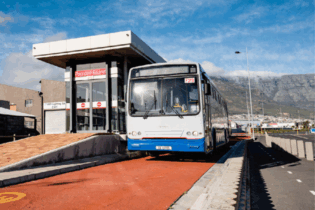Sub-Saharan Africa is becoming an increasingly attractive investment frontier. James Milne, Sarah O’Carroll and Craig Parker, Senior Consulting Analysts, Frost & Sullivan, Africa look at this region, offering advice to those striving to move freight through the region.
With several of the fastest growing economies located in sub-Saharan Africa, companies from around the world are looking to enter the region in order to escape aggressive competition in their home markets and improve sales. For these companies, gaining an understanding of the state of infrastructure at a country level will be critical in order to mitigate potential risks. In conjunction with energy and communications infrastructure, efficient transport and logistics infrastructure is fundamental to operational success.
On a macroeconomic level, transport and logistics infrastructure provides access to consumer markets, connects raw materials to beneficiation markets, promotes regional integration and ultimately, improves connectivity to the global economy. On a microeconomic level, transport and logistics infrastructure has a direct impact on a country’s handling capacity for imports and exports, distribution route development, the frequency of shipments and the cost for freight handling, storage, distribution and related services. All these factors affect how competitive a company can be within a market – particularly with regards to companies that are highly reliant upon efficient supply chain management, or strategic sourcing.
Regional transportation network overview
Sub-Saharan Africa is plagued by poor and under-developed transportation infrastructure, limiting accessibility to consumers, hampering intra-regional trade and driving up import and export costs.Southern Africa is the most developed region, from an infrastructure and intra-regional connectivity perspective. Perhaps most notable is the widespread use of rail as a key mode of transport for freight transportation in Southern Africa –an option which is currently heavily under-utilised in the rest of Sub-Saharan Africa.
East and West Africa are regional growth ‘hotspots’ –from an economic perspective, but also due to the numerous multinational companies targeting these regions for expansion. Compared to Southern Africa, transport and logistics infrastructure in these regions are very poor. The infrastructure has been poorly maintained, resulting in dilapidated and over-congested roads, poorly functioning railway systems and inadequate airports. Regional connectivity isbetter in East Africa when compared to West Africa – a factor which can possibly be attributed to the fact that East Africa is not currently a resource-based region (major resource discoveries of a commercially viable nature have only been made in the past 10 – 15 years). This has historically resulted in the promotion of intra-regional trade links (and infrastructure) in order to drive growth for companies operating in the region, by offering access to alternate markets.The East African Community (EAC) has also introduced regulations which seek to promote intra-regional trade. Unlike East Africa, the mineral wealth of West Africa has been known for decades – and has to a large extent driven an individual-country focus to infrastructure development, as countries have less need to trade with each other, and prefer to focus on moving resources to ports internally. As a result, intra-regional trade volumes remain low and the regional infrastructure network is poor.
There is a significant lack of infrastructure in Central Africa, due to political instability for almost three decades. Although rich in resources, Central Africa remains one of the most difficult and costly regions for companies to successfully penetrate. The void of development in Central Africa is a key barrier to connectivity between North, East, West and Southern Africa. Major progress towards improving transport and logistics infrastructure in Central Africa is unlikely over the next decade; a real improvement can only be expected by 2040.
Improving infrastructure and its impact
African governments across all regions have re-prioritised the rehabilitation, upgrading and expansion of transportation infrastructure in order to rapidly improve trade, both international and intra-regional. Frost & Sullivan’s analysis of infrastructure development in Sub-Saharan Africa reveals that US$174 billion (R1 800 billion)is being invested in transport and logistics infrastructure in the region. US$ 28 billion dollars is being invested in the development of major Trans-African road and rail corridors and deep-sea ports in order to rapidly improve trade volumes in sub-Saharan Africa.
Current estimates indicate that trade volumes in sub-Saharan Africa will more than triple from 102.6 million tonnes in 2009 to 384.0 million tonnes in 2030, if the trade corridors are completed. In 2009, Southern Africa was driving trade volumes in the region, accounting for approximately 64% of total trade. By 2030, Southern Africa’s contribution to total trade volumes is estimated to be reduced to 53% as trade in other regions improves. Trade in East and West Africa is expected to grow to 181 million tonnes and 300 million tonnes respectively, with growth in West Africa slightly faster than that of East Africa.
The development of rail corridors will have a substantial impact on intra-regional trade, with trade between African countries expected to increase from 34.9 million tonnes in 2009 to 120.4 million tonnes in 2030. Resource-rich landlocked countries in particular will see significant benefits. Trade in oil-rich Uganda, is projected to increase at a rate of 8.2% year on year to 2030, while trade in Zambia is projected to grow by 9.7% year on year between 2009 and 2030.
How will transportation corridor development evolve?
Trade will not increase at the same rate across sub-Saharan Africa,as trade corridor development is projected to occur in three distinct phases. The first phase of development will be the strengthening of trade routes between Southern African countries. Transport and logistics infrastructure is already relatively well established and investment is focussed towards improving rail links between countries in the area. Significant portions of trade corridor development are expected to approach completion by 2020. The second projected phase of trade corridor development will be driven by strengthening Southern and East African trade links. Although both road and rail links already connect the two regions, significant rehabilitation and improvement is required to manage increasing trade volumes. Based on ongoing projects, Frost & Sullivan estimates that these links should be greatly improved by 2030. Significant greenfield construction is required to improve regional connectivity because West Africa has historically undertaken transport and logistics infrastructure development on a country-by-country basis. Once complete, several mega-projects in the region will greatly improve the ability of large multinationals to transport resources, and deliver products and services to multiple markets in West Africa. Because of the poor state of infrastructure in the region, improvements to trade links in West Africa can only be expected by 2040 or beyond. What does this mean for business? Understanding the evolution of trade corridor development is extremely important when considering access to consumer populations and the challenges associated with logistical networks. Markets in sub-Saharan Africa are often over-estimated, as the current state of transport and logistics infrastructure is not regularly taken into account when calculating the size of a potential market. As consumer markets in the developed world mature, a great deal of emphasis has been placed on Africa’s burgeoning middle class and its vast growth potential – creating expectations of a large, untapped, yet accessible consumer population which is eager for new products and services. The size of Africa’s middle class is highly dependent on the factors used when making such projections and is, thus highly variable. As a result, projections in the public domain range between 32 million and 350 million people.Because projections are heavily weighted towards demographic and socio-economic factors and consumer purchasing trends, the projected size of Africa’s middle class is usually over-estimated. This gives companies looking at Africa for geographic expansion, unrealistic views of their growth potential. Rather than estimate the size of the African middle class, companies are usually just trying to estimate the spending potential of middle class consumers within a country. Often, spending potential will be estimated using earnings – if earnings fall within a certain range, then the person is considered to be ‘middle class’. This however does not predict how consumers spend money. A more comprehensive approach would be to use indicators such as living in a formal dwelling, access to running water, electricity and internet and owning a fridge, television, stove and mobile phone. Using average spending potential in Africa does not give particularly accurate estimations as there is too much income inequality. In countries with extractive industries, there are many more poor people compared to rich people and only the rich get richer, driving up the average spending potential. Using average spending potential will usually provide an over-estimate,and false growth potential. Using a combination of earnings and socio-economic indicators, Frost & Sullivan estimates that Africa’s middle class is between 50 million and 60 million people.This middle class would however be poorer than its counterparts in Europe and North America with earnings between US$1,000 (R10 349)andUS$2,000 (R20 692) per month, live in a formal dwelling, have running water, a flushing toilet, electricity, a stove, fridge, television and access to the internet. The small size of Africa’s middle class does not mean that sub-Saharan Africa has no potential for companies undergoing geographic expansions, but it does require companies to take considerable care when determining what the addressable market is for their products or services. Not only should a more suitable definition be used for estimating the size of an addressable market, but the actual accessibility of markets should also be taken into account. Poor transport and logistics infrastructure in many sub-Saharan African countries, results in some areas being largely cut-off from traditional consumer markets. As a direct result of this oversight, a number of companies that have expanded into sub-Saharan Africa have suffered severe setbacksbased on unrealistic expectationsof the actual accessible market. For companies lookingto expand geographically intosub-Saharan Africa, it is crucial to develop a strong understanding of the consumer markets and infrastructure present in the markets they wish to enter. This will allow companies to make better estimations of the size of their addressable market as well as develop mitigation strategies associated with supply chain management and sourcing.







